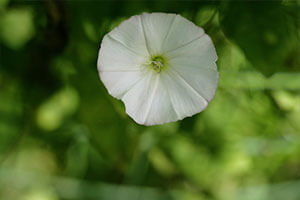
Family Convolvulaceae—The Morning -glory Family
The Convolvulaceae consists of twining herbs, trees and shrubs. The family is made up of about 50 genera and between 1400-1650 species. Because of its variability the family is a little messy to deal with. Most of the trees and shrubs don’t occur in North America and are therefore of little interest to North American beekeepers. In North America the family consists of mostly annual and perennial, often twining herbs that often have milky sap.
The leaves are generally simple (rarely compound)1 and are alternately placed (not placed opposite each other on their stem) and are generally without or have only small stipules.2
The flowers are bisexual (have both stamens and pistils), are twisted in their buds, and radially symmetrical3 and usually shaped like a funnel (funnelform), usually made up of 5 parts (5-merous) as for example 5 largely united petals, and 5 sepals (parts that originally covered the bud). The petals and sepals are attached below the ovary (i.e. the ovary is superior to these floral parts). There are usually five stamens that are attached to the petals and alternate with the lobes of the flower. The female parts of the flower (pistil and ovary) usually consist of two but sometimes 3-5 united carpels4 with the immature seeds developing along the central axis of the ovary (axile placentation). There can be one or two complete styles, or the style may be split into two partial styles. Where there is only one pistil, there are frequently 2 stigmas (where the pollen is deposited).
The fruit is a capsule, berry or nut.5 If you recognize a morning glory, you will most likely be able to recognize much of this family.
Nine genera are native to the U.S. The family’s importance resides in the sweet potato, several ornamentals and several weeds, some of these quite serious.
Reference
Smith, J. P. 1977. Vascular Plant Families, Mad River Press Inc. Eureka, California.
Field bindweed, European bindweed, small-flowered morning- glory, creeping Jenny, European glorybind, European bindweed, cornbine, lesser bineweed, barbine, corn bind, devil’s-guts, greenvine, corn-lily, laplove, hedge-bells, liseron des champs and liseron.
Scientific name: Convolvulus arvensis
Synonyms: Convolvulus ambigens, Convolvulus incanus
Origin: Convolvulus arvensis was introduced from Europe into New England in 1739 and had spread to California by 1900. The first Canadian report was made from Ontario in 1879, and by the 1890’s the plant had spread to western Canada. This is an important weed. It can reduce crop yields by 50% and once established, it is very difficult to control. The plants can survive -10o C (14oF) and its roots have been known to grow 9m (~29.5 ft) deep. A severe infestation can produce over 800 kg (~1764 lbs) of seed per acre.[11]
Plant description: Field bindweed is an aggressive perennial and in extensive infestations the 2-7 ft (~0.6-2.1 m) long vines twine and spread over the ground, forming tangled mats or climbs on existing supports.
The leaves are placed alternately on the vine and are quite variable in shape, varying from nearly round except for two basal lobes, to the more common triangular to oblong shape, 1-6 cm (~0.39-2.36 in ) long and 3 cm (~ 1.2 in) wide, usually with two basal lobes. The unattached leaf end ranges from pointed to rounded. Except for the basal lobes, the leaf edges are smooth without teeth or other indentations.
The flower stems arise from the angle between a leaf and the …
PHOTO CAPTION
Flower of Convolvulus arvensis (Field bindweed), Photo taken in the W.J. Beal Botanical Garden on the Michigan State University Campus in the Economic Weeds III. Persisting Weeds Collection on 8/7/2015.


